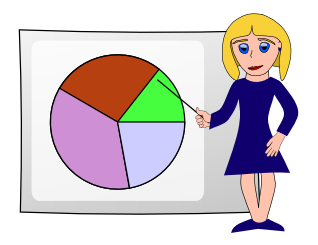 A colleague of my husband’s recently forwarded me a PowerPoint template that he was required to use for a presentation he was giving at a particular event (let’s call it XYZFest). He was lamenting its many flaws and wondering how he would be able to make a decent presentation from such a lousy template.
A colleague of my husband’s recently forwarded me a PowerPoint template that he was required to use for a presentation he was giving at a particular event (let’s call it XYZFest). He was lamenting its many flaws and wondering how he would be able to make a decent presentation from such a lousy template.
It’s not easy to design PowerPoint templates, because you never know who the end user will be and how experienced with PowerPoint they are. But there are some things you can do to mitigate some of the bad things PowerPoint can do in the hands of the untrained presentation designer.
Select Neutral Background Images
The image that appears on every XYZFest slide is an anonymous, techy background filled with grids, swooshes, and garish colors: orange, teal, lime green, dark brown, and navy blue. This overly busy graphic diverts attention away from the message of the slide.
Choose Good Theme Colors
The XYZFest colors are bad enough, but the theme colors for the template were worse: white, black, dark grey, black, light grey, mustard, white, black, light grey, and dark mustard. These colors are applied to every imported or created graph or table, creating an ugly mess. They could at least have developed theme colors that echoed or coordinated with the colors in the main image.
Don’t Take Up Too Much Real Estate
It’s not necessary to place a company logo on each slide of a presentation. People generally know their location, who their hosts are, and why they’re there. The XYZFest graphic is vertical and takes up about 1/5 of the left side of the slide. This positioning is awkward and distracting, since most slides are built with some sort of graphic on the top or bottom. Anybody importing their decks into this template was faced with having to adjust the layout on all of their slides.
Make the Title Slide Editable
The title slide in XYZFest’s template used a placed graphic that included the name and date of the conference. Since the text was part of the placed graphic, it was uneditable. So each presenter’s deck started with the same slide, a continuous reminder of what the conference is called and what time of year it is. Title slides are supposed to let the audience know what the presenter’s name is and what he’s going to be talking about, not a constant advertisement for the venue. Make sure they can be edited.
Master Slides Don’t Match Background Images
Only two slide layouts were adjusted to match the background images. All of the other layouts were left as-is, meaning that text and graphics placeholders ran across the images. If you’re going to create a custom template, you should delete all unused layouts.
Templates are designed to create uniformity across multiple presentations. But if you provide an ugly template, the bad design will be back to haunt the audience each time a different presenter steps to the podium.
